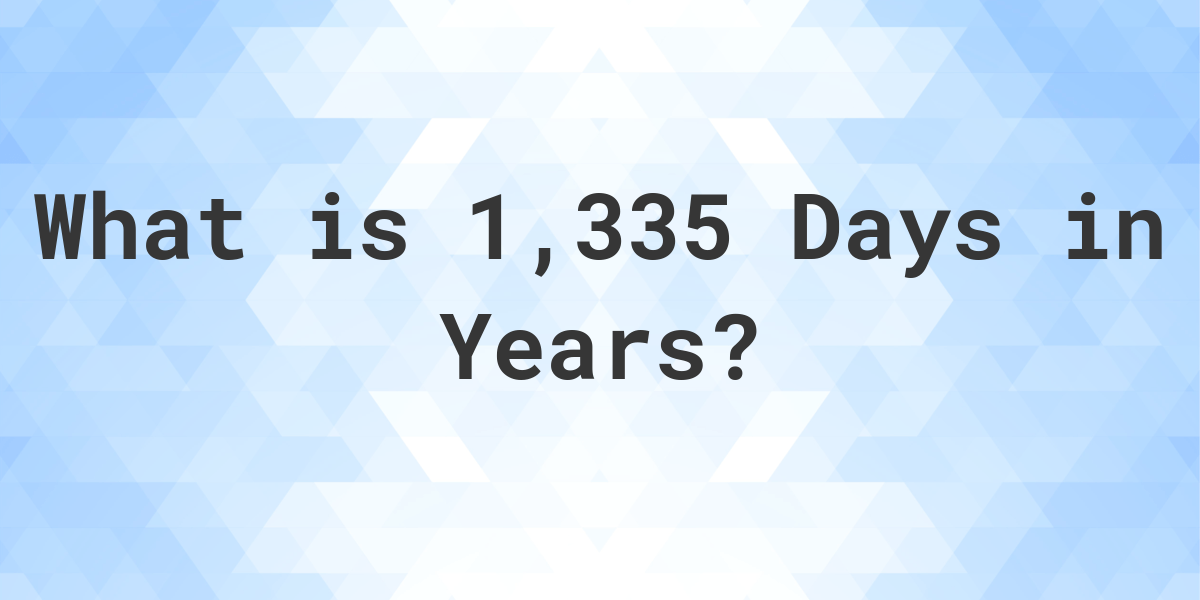Understanding time conversions can often feel like a perplexing puzzle, but fear not! Today, we embark on an intriguing journey to unravel the mystery: 1,335 days—how many years does that translate to? This whimsical challenge invites you to explore not just the conversion itself but also the various aspects intertwined with the concept of time, engaging the creativity and curiosity of your mind.
Before we plunge into calculations, let’s entertain the fundamental relationship between days and years. A standard year comprises 365 days. However, in leap years, this count increases to 366 days—an occurrence which manifests every four years. Leap years exist to keep our calendar in sync with the Earth’s revolutions around the sun. Thus, depending on how many leap years fall within your span of interest, the conversion from days into years might slightly fluctuate.
Now, to the core of our computation: to convert 1,335 days into years, we commence with the basic formula:
Years = Days ÷ 365
By substituting our specified number, we find:
Years = 1,335 ÷ 365
The result is approximately 3.65 years. Surprised? That’s just a little over three years and about seven and a half months. This quick conversion gives you a solid foundational understanding, but the exploration doesn’t end there!
Let’s add some context to this conversion. To further grasp the significance of 1,335 days, let’s examine what can transpire in such a span. Specialists estimate that the average human lifespan hovers around 79 years. Thus, 1,335 days represents about 4.6% of a life. This numerical perspective metamorphoses the mundane notion of time into a broader reflection on existence, emphasizing not just the passage of days but the stories that accompany each moment.
To enhance our understanding, let’s take this conversion deeper by exploring the more specific nature of months. A typical month can be approximately 30 or 31 days long, although February often threatens this uniformity with just 28 days or 29 in leap years. To further decode our transformation of days into a more relatable measure, we can convert 1,335 days into months.
Using an average month length of about 30.44 days (the yearly total of 365 divided by 12), we find:
Months = Days ÷ 30.44
Calculating this yields:
Months = 1,335 ÷ 30.44 ≈ 43.8 months
In other words, 1,335 days is about a staggering three years and seven months, adding a fresh perspective to the time frame.
Now, if you mentally picture what could occur during 1,335 days, you might conjure images of various life events. Consider what has transpired in your life during just a few years: potential career shifts, educational pursuits, relationship transformations, travel escapades, and unexpected adventures. Each of these moments is cradled within the temporal tapestry created by days and years.
One might also delve into the implications of historical events within this time frame. The world has witnessed a multitude of pivotal incidents that have shaped societies in spans as short as 1,335 days. Consider inventors refining technology, movements gaining momentum, or reformative ideas unfolding. Suddenly, the abstract concept of time clutches your imagination and invigorates your curiosity.
In seeking to understand the essence of those 1,335 days, think of milestones. One may ponder: how many birthday celebrations does that encompass? How many holidays, vacations, and cherished memories do people capture during this period? It’s a powerful reminder to embrace not merely the numerical digits but the moments that evanesce and the experiences that define a life lived.
Moreover, time’s relativity plays a compelling role in our perceptions. Does it feel like years fly by in a delightful rush, or do certain days linger interminably? Perhaps it’s a mix of both, depending on the ebb and flow of our daily lives. This duality is a testament to our human experience and our myriad of memories. Think back: what stands out most vividly in your timeline of 1,335 days? Was it triumphs, challenges, or quiet reflections?
As you wade through this number, let’s consider practical applications as well. For example, how can knowing that 1,335 days translates to about 3.65 years affect your planning? Financial goals, travel itineraries, or educational pursuits can all be better organized with a grasp of time. The more equipped you are at visualizing periods, the more adept you become in navigating life’s labyrinth.
To reinforce your newfound knowledge, engage with a light-hearted challenge: try isolating significant events that you associate with your past 1,335 days. Or perhaps forecast what the next 1,335 days might hold in store for you. Approach it like an artistic canvas, splashing on dreams and aspirations.
In conclusion, this exploration into the translating of 1,335 days into years not only announces a straightforward conversion but encourages you to recognize the depth of time itself. With our frenetic pace of modern life, dedicating time to ponder these conversions may seem trivial, but it yields opportunities for introspection and imagination—a fine amalgamation of mathematics and reflection. Embrace the challenge and keep an eye on the clock; opportunities and experiences await in every tick and tock!

